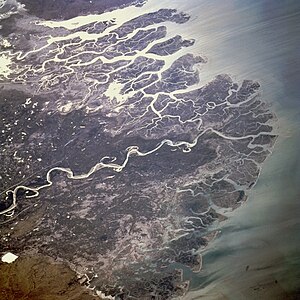| Designations | |
|---|---|
| Official name | Indus Delta |
| Designated | 5 November 2002 |
| Reference no. | 1284[1] |

The Indus River Delta forms where the Indus River flows into the Arabian Sea, mostly in the southern Sindh province of Pakistan with a small portion in the Kutch Region of India. The delta covers an area of about 41,440 km2 (16,000 sq mi), and is approximately 210 km (130 mi) across where it meets the sea. The active part of the delta is 6,000 km2 in area (2,300 sq mi). The climate is arid, the region only receives between 25 and 50 centimetres (9.8 and 19.7 in) of rainfall in a normal year. The delta is home to the largest arid mangrove forests in the world,[2] as well as many birds, fish and the Indus dolphin.
Since the 1940s, the delta has received less water as a result of large-scale irrigation works capturing large amounts of the Indus water before it reaches the delta. The result has been catastrophic for both the environment and the local population.[3] As a result, the 2010 Pakistan floods were considered "good news" for the ecosystem and population of the river delta as they brought much needed fresh water.[4][5]
The population of the active part of the delta was estimated at 900,000 in 2003.[6] Most of the population depends on agriculture and fishing. Mangrove forests provide fuel wood. Many former settlements in the delta have been abandoned as result of lack of water in the Indus and the encroaching Arabian Sea.
- ^ "Indus Delta". Ramsar Sites Information Service. Retrieved 25 April 2018.
- ^ Cite error: The named reference
Hogarthwas invoked but never defined (see the help page). - ^ "Ignored by Pakistan, the Indus delta is being lost to the sea". 5 May 2020. Retrieved 5 May 2020.
- ^ Walsh, Declan (2010-10-21). "Pakistan floods: The Indus delta". The Guardian.
- ^ Walsh, Declan (2010-10-05). "Pakistan's floodwaters welcomed along Indus delta". The Guardian.
- ^ Cite error: The named reference
IUCNwas invoked but never defined (see the help page).